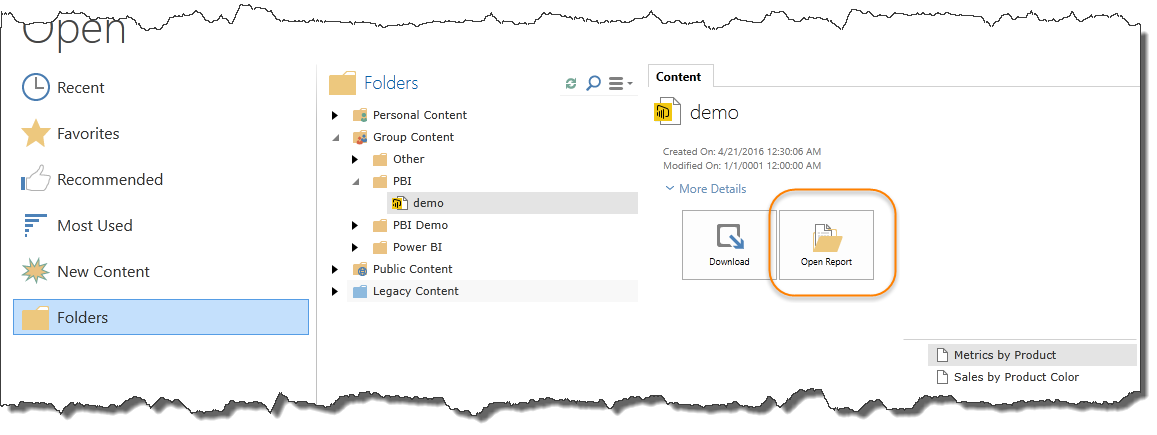Power BI
Two Methods to Access Power BI Content
Publish from Power BI Desktop to Pyramid
Power BI content can be published to BI Office using the "Publish to Pyramid Analytics" feature in Power BI Desktop. This capability allows users to share Power BI views with other in the enterprise using the on-premise and private cloud deployment options of BI Office (rather than the public cloud offering from powerbi.com).
Import PBIX Files Into Pyramid
If you don't have access to the "Publish to Pyramid Analytics" feature, you can import PBIX files directly into BI Office using the Import Power BI File command in the content management system, as shown below.

Working with Power BI Content
Once the Power BI Content is imported into BI Office, it can be viewed directly or embedded into BI Office interactive story boards.
Within a story board, the content can be wired up with interactions so it can respond to global slicers and other elements on the slide. Further, multiple Power BI elements can be presented on the same slide, using multiple, independent data sources.
"Publishing to Pyramid Analytics"
Open Power BI Desktop (version 2.35 or greater).
- Create content with a live connection to Analysis Services Multidimensional or Tabular model, or choose existing content with a live connection.
NOTE: Only live connected data sources are currently supported
- From the file menu, select Publish, and then select Publish to Pyramid Server.

- Enter the server URL for the Pyramid Analytics BI Office instance. This is something that you can get from your BI administrator.
IMPORTANT: Because of the authentication requirements, the address should be something that can accessed from your local area network. Alternatively, the site should accept Windows Authentication with relevant ports open on the firewall.
IMPORTANT: You may get errors during the publishing process. These will be presented in a small warning icon to the right of the URL text box. Click here for publishing error explanations.

- Click next.
- If there are no issues select the destination content folder in BI Office either Private Content, Group Content, or Public Content.

- Then click Publish to upload the content.
 For more see the video tutorial.
For more see the video tutorial.
Inserting Power BI Content in BI Office
Power BI content can be opened directly from the folder system. In this mode, the content is opened as is (orange highlight below)

To build composite story boards of content, sourced from multiple elements including Power BI and BI Office content, use the story embedding feature, described below. More details are available here.
WARNING: Power BI is not memory efficient. See tips below for managing memory.
Memory Optimization
Power BI objects require a substantial amount of browser memory. Most browsers do not release memory until the session ends and the browser is closed. BI Office has been optimized to give back as much memory as possible, however, this can still be an issue if there are too many Power BI objects on a slide or a story board deck.
In cases where there is a need for multiple Power BI objects on a slide, consider using a single Power BI “page” with the multiple elements inside BI Office, rather than multiple individual Power BI panels. For example, four objects on a Power BI report page uses the same amount of memory as one object on the page. Rather than creating one report page per object, consolidate Power BI objects into the least number of report pages where possible.
It is highly recommended to limit the number of Power BI panels in BI Office dashboards to no more than 2 per page or 6 overall for general client consumption on typical PC configurations.
Last, in instances where a substantial number of Power BI objects are being published to Pyramid, consider migrating some objects to BI Office where memory consumption is significantly more efficient.
Manage Published Power BI Content
Within BI Office, navigate to the folder where the content was published.
- Select the Power BI report in the file tree.
- In the Content pane on the right side of the screen, choose the Open Report option to open the report object within BI Office. Interact with the report object using the Sort Options available under More Options button. Hover over areas of the report object to get details about the data in the report.
- Choose the Download Power BI option to download a .pbix file of the report.
- Govern access to Power BI content using the Security pane on the right side of the screen. Check the box next to Read to allow access for various roles in BI Office.
Additional options available by right clicking on the Power BI file:
- Select Rename to rename the Power BI file.
- Select Change Description to change the file description.
- Select Delete to delete the file from the BI Office content library.
- Choose Data Source Changer to change the data source that the Power BI object connects to.
Downloading PBIX
Published/uploaded PBIX files can be extracted from BI Office using the "Download" button from the Open page in the BI Office backstage (purple arrow above).
Home |
Table of Contents |
Index |
User Community
Pyramid Analytics © 2011-2022

